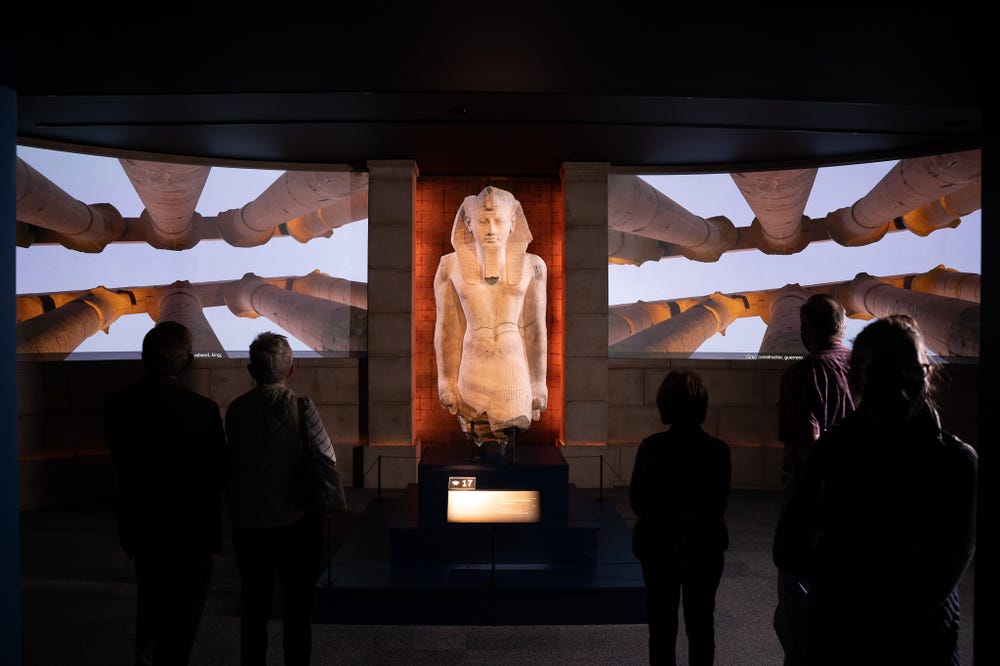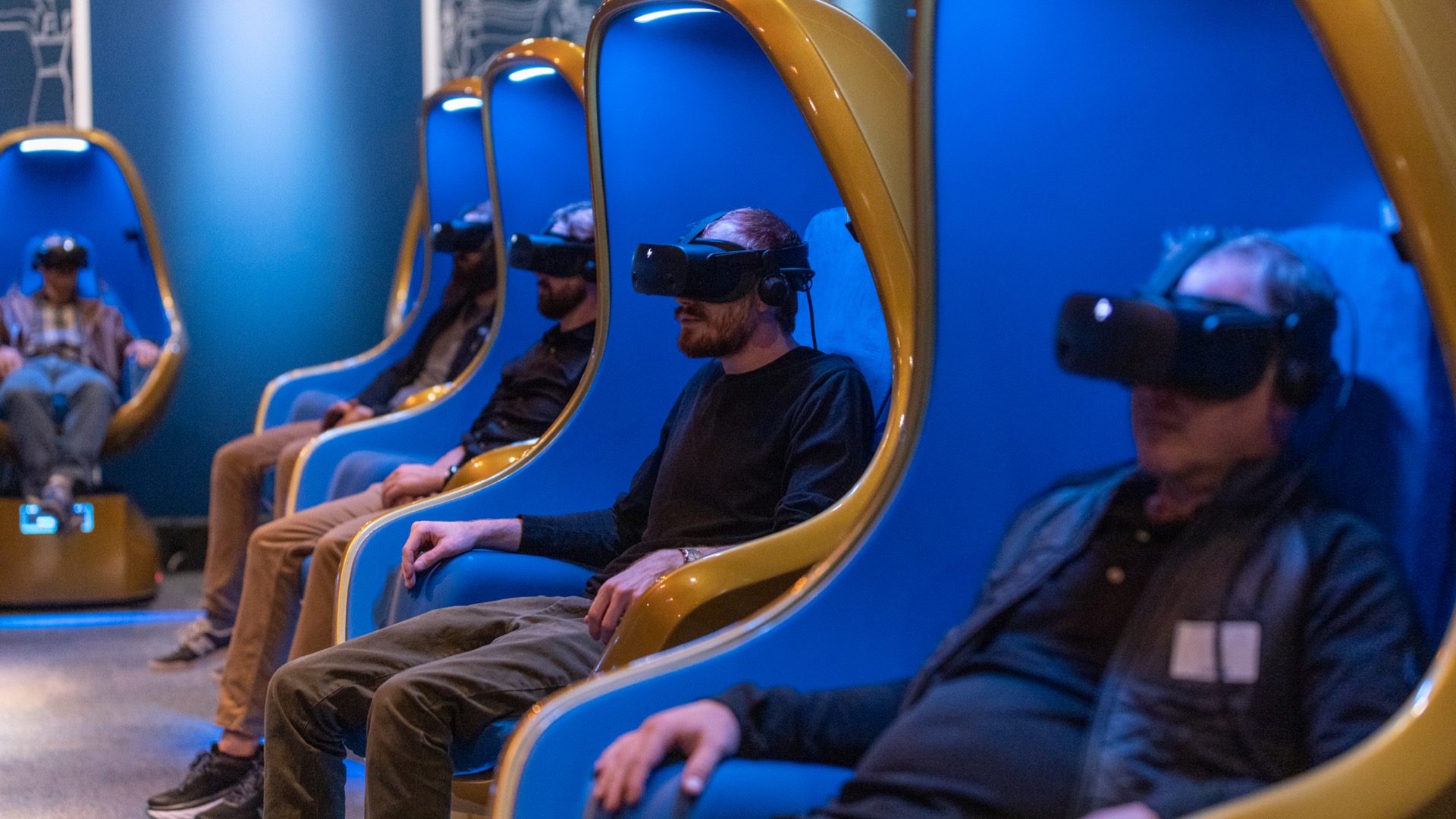13 Preserving Potential
RAMSES THE GREAT AND THE GOLD OF THE PHARAOHS AND RETHINKING THE IMMERSIVE EXHIBIT
Ryann Liljenstolpe
Preserving Potential: ramses the Great and The Gold of the Pharaohs And Rethinking the Immersive Exhibit
/https://tf-cmsv2-smithsonianmag-media.s3.amazonaws.com/filer_public/27/3e/273e9656-c548-4ab2-bee6-5f735d618c66/ramses_the_great_and_the_gold_of_the_pharaohs_photo_1.jpg)
The Exhibit:
In November 2021, the Houston Museum of Natural History debuted a brand new traveling exhibit, titled “Ramses the Great and the Gold of the Pharaohs.” The exhibition, which features 181 artifacts on loan from the Egyptian government, combines history and spectacle in its celebration of the 19th dynasty ruler Ramses II.1 Guests are greeted with replica columns, faux sandstone walls, and glowing cartouches alongside the massive red granite statue of Ramses’ head that the pharaoh commissioned during his reign. Reviews of the exhibition emphasize the spectacle as a selling point. An early review from Chron says: “Entering the exhibit gateway feels like stepping into a Hollywood movie set. The lighting, music, desert-like quietude, the rows of replica columns — we’re off to ancient Egypt.”2

THE PROBLEM:
The exhibition’s designers made prominent use of video and digital renderings in order to engage with guests on multiple levels. A screen in the corner of a room displaying sarcophagi shows a digital recreation of Ramesseum and the temple of Abu Simbel as they may have appeared when Ramses had them built. A drone shot of the stone ruins transforms as the hieroglyphs on the walls regain their bright red, green, and turquoise colors, creating a breathtaking effect. However, while the technology is impressive, the spectacle of these videos runs into dangerous territory when they attempt to portray real people from history.
/https://tf-cmsv2-smithsonianmag-media.s3.amazonaws.com/filer_public/92/40/92408193-f4e3-48f4-a43a-6a63d8ac7d4c/ramses_the_great_and_the_gold_of_the_pharaohs_photo_29.jpg)
For an additional cost, visitors to the exhibition are invited to a fully immersive virtual reality experience, titled “Ramses and Nefertari: Journey to Osiris.” The VR experience takes place in a moving, pod-like chair stylized to look like a massive gold scarab.3 The show opens with a beautiful exterior shot of Abu Simbel. The viewer then enters the temple and is treated to a panoramic view of the massive interior columns and statues.4 This is where the positives of the experience end, however. A shimmering apparition, Nefertari, enters the temple. Following the time-honored Hollywood traditions of depicting ancient Egyptian rulers, Nefertari’s character design is both heavily whitewashed and oversexualized. After her introduction, the viewer is chased through the desert by Ramses’ “angry ghost” in the form of a massive sand monster. The viewer escapes the monster and returns to the temple, where Nefertari informs them that Ramses’ spirit is now calm and wishes to meet them. The pale-skinned, heavily muscled Ramses character speaks not even with Nefertari’s borderline cartoonish generic “middle-eastern” accent, but with the gravelly tones of an American action star. The experience does not offer any deeper knowledge of these rulers, only the most basic laundry list of their achievements with a heavy dose of Hollywood drama and racist stereotypes.

SOLUTIONS:
/https://tf-cmsv2-smithsonianmag-media.s3.amazonaws.com/filer_public/de/42/de4254a8-6eed-4ddf-8f16-90d7ce40bc43/gettyimages-110869544.jpg)
After experiencing the exhibit myself at the deYoung in San Francisco, I was deeply disappointed in the missed potential of a VR experience. The technology could be used to such good effect, but instead it turned the exhibition into a theme park. I was ruminating on this fact while going through the exhibit when I turned a corner into the last room. Just next to the exit was a small video screen showing the exhibition’s curator, famed egyptologist Zahi Hawass, explaining his project to restore the temple of Abu Simbel after it was severely damaged by years of flooding. This video more than any other caught my attention. Here was something not computer generated or overdramatized, but a man who has dedicated his entire life to this work talking about the process while standing at the actual site surrounded by members of his team. I could not believe that this video was relegated to an afterthought while something like “Journey to Osiris” was put front and center. It is made utterly clear by this exhibition that spectacle and entertainment were prioritized far above education. However, my solution that I will explore in this project reimagines the VR experience as one of immersive archaeological exploration. The viewer will follow Hawass and his team through the site of restoration, getting the opportunity to hear about the temple, its history, and its future through the mouths of people who are truly passionate and knowledgeable about it.
The above video was published by Heritage Key Media in 2009.5 In it, Hawass explains the excavation and restoration of Egypt’s oldest pyramid, the Step Pyramid of Djoser. The video has the air of an exclusive tour, as if we as the viewer are being let in on a precious secret. Perched casually on top of the granite covering the sarcophagus, Hawass says: “People always love to hear about discoveries and ‘secrets from the sand’ and mummies and things like this, but what I am going to tell you now…is more thrilling than a discovery.” He goes on to explain the labor intensive and often precarious process of excavating each chamber of the pyramid as we are shown photos and clips of the team shimmying through cramped passages and shining flashlights on massive carved blocks cleared from the rubble. Far from being a standard progress report, history lecture, or walking tour of a site already cleared and restored, the video conveys the unmistakable energy of a site in progress. The work is being done, and to a certain degree we have been allowed to see it. Hawass’ excitement is clear and contagious. It is clear not only that the monument itself is important (historically, technologically, etc) but that the process of restoration is both worthwhile and thrilling beyond any flashy discoveries or contrived narratives.
Though the Heritage Key Media video is over 13 years old, it could be the blueprint for a far more progressive VR exhibition than what “Journey to Osiris” offers us today. I imagine the experience taking the form of a similar tour of the Abu Simbel site, where the viewer accompanies Hawass on a walkthrough of the site before joining the team in a section of the temple that is actively being restored. The viewer has the opportunity to hear input from an archaeologist, a restorator, and an engineer on how best to solve a particular problem. In a parallel to the “break the slab” moment from the Heritage Key video, a decision must be made. The viewer will be present for that process, invested in the outcome, and able to see whether or not it pays off. Better than constructing a fictional narrative for the viewer to passively enjoy, in this scenario we are actually present for the work in progress. This is also an opportunity for VR technology to shine, as unlike in the Heritage Key video the viewer will be able to experience more of the site than they would through a static camera shot. One of the most intriguing aspects of VR is that it allows us to notice more, to look at our surroundings beyond the perspective that a cinematographer might choose for us. Creating an immersive VR experience that leans into this agency from the audience, that encourages us to look closely at our world and be present in it, is absolutely crucial to reversing the harmful effects of empty, uncritical media like “Journey to Osiris.”
References:
[1] Ramses the Great and the Gold of the Pharaohs. (2022). FAMSF; Fine Arts Museums of San Francisco. https://www.famsf.org/exhibitions/ramses-great-and-gold-pharaohs#stories
[2] Soslow, R. (2021, November 22). Review: Huge, immersive “Gold of the Pharaohs” exhibit is a must-see at HMNS. Chron; Hearst. https://www.chron.com/culture/article/houston-science-museum-HMNS-Ramses-exhibit-16641926.php
[3] Ramses the Great and the Gold of the Pharaohs. (2021). Ramses the Great; Cityneon Group & World Heritage Exhibitions. https://ramsestheexhibition.com/#about
[4] Ramses VR. (2021, December 6). Www.youtube.com; Virtual Worlds. https://youtu.be/IqZSfdR9Ebw
[5] Exploring the Step Pyramid, Ancient Egypt’s “Stairway to Heaven” – Dr. Zahi Hawass. (2009, April 28). Www.youtube.com; HeritageKeyMedia. https://youtu.be/t5VsldNp83s
Additional image source:
Schkloven, E. (2022, January 27). An Immersive Celebration of Ramses II Transports Visitors to Ancient Egypt. Smithsonian Magazine; Smithsonian Magazine. https://www.smithsonianmag.com/history/an-immersive-celebration-of-ramses-ii-transports-visitors-to-ancient-egypt-180979444/

